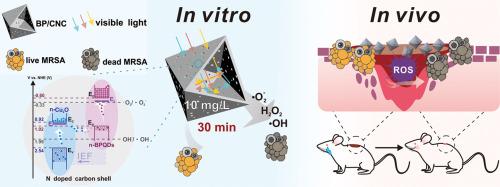Journal of Hazardous Materials ( IF 12.2 ) Pub Date : 2021-09-21 , DOI: 10.1016/j.jhazmat.2021.127281 Shijia Luo 1 , Ruixi Liu 1 , Xixi Zhang 1 , Rui Chen 1 , Mingming Yan 1 , Kerang Huang 2 , Jing Sun 3 , Rong Wang 1 , Jianlong Wang 1

|
Photocatalysis has been regarded as a promising inactivation technology targeting to reduce drug-resistant bacteria contamination, but developing efficient photocatalysts with broad visible light harvesting capability is still a challenge. Here we report a MOFs-derived BPQDs/Cu2O/N-doped hollow porous carbon (BP/CNC) with indirect Z-scheme heterojunctions (BPQDs/Cu2O), which can inactivate 99.99999% Methicillin-resistant Staphylococcus aureus (MRSA) at a concentration of only 10 mg/L. Combining photoelectrochemical techniques and electrochemical measurements, the efficient inactivation process was attributed to the synergistic effect of enhanced light utilization and effective suppression of photogenerated carrier recombination. The mechanism of gradually damaged cell membrane for MRSA was studied by employing scanning electron microscopy (SEM), fluorescence staining and coagulase titer test to further decipher the changes in bacterial cells. We propose that reactive oxygen species (ROS) destroys the cell wall membrane and causes the leakage of cell contents, eventually leading to death. In addition, a series of in vitro and in vivo toxicity tests were conducted to evaluate the biocompatibility of the antibacterial system and its potential use in practice. This strategy of BPQDs/Cu2O indirect heterojunction fabrication can spatially inhibit the recombination of photogenerated carriers, expands the light absorption range, providing a feasible method for disinfecting microbial contaminated water.
中文翻译:

基于间接Z型异质结黑磷QDs/Cu2O纳米粒子合理设计的超高效光催化水消毒机理研究
光催化被认为是一种很有前途的灭活技术,旨在减少耐药菌污染,但开发具有广泛可见光捕获能力的高效光催化剂仍然是一个挑战。在这里,我们报告了一种具有间接 Z 型异质结 (BPQDs/Cu 2 )的 MOFs 衍生的 BPQDs/Cu 2 O/N 掺杂的中空多孔碳 (BP/CNC)O),仅在 10 mg/L 的浓度下就可以灭活 99.99999% 的耐甲氧西林金黄色葡萄球菌 (MRSA)。结合光电化学技术和电化学测量,有效的灭活过程归因于增强光利用率和有效抑制光生载流子复合的协同效应。采用扫描电镜(SEM)、荧光染色和凝固酶滴度试验研究MRSA细胞膜逐渐受损的机制,进一步破译细菌细胞的变化。我们提出活性氧(ROS)破坏细胞壁膜并导致细胞内容物泄漏,最终导致死亡。此外,一系列的 体外和体内进行了毒性测试以评估抗菌系统的生物相容性及其在实践中的潜在用途。这种BPQDs/Cu 2 O间接异质结制备策略可以在空间上抑制光生载流子的复合,扩大光吸收范围,为微生物污染水的消毒提供了一种可行的方法。











































 京公网安备 11010802027423号
京公网安备 11010802027423号